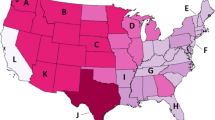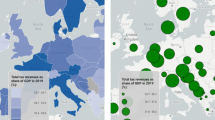Abstract
Problem analysis in designing thematic maps and user interfaces which assist map designers in incorporating their ideas into maps are presented.
Problems in designing choropleth maps are analyzed from the map designers point of view. A graphical user interface, called “Histogram Interface”, is implemented as countermeasure for problems in designing choropleth maps. The user interface can assist map designers in representing their ideas and achieving the desired maps through the designing process. The user interface operations, which correspond to the map designer's ideas, are explained. The user interface effectiveness is confirmed by resulting map examples and the corresponding graphical patterns on the interface.
A concept is proposed concerning the importance in any computer graphics field, which the designers should consider in determining how to incorporate their ideas into pictures.
Similar content being viewed by others
Explore related subjects
Discover the latest articles and news from researchers in related subjects, suggested using machine learning.References
Cleveland WS, Horris CS, McGill R (1983) Experiments on quantitative judgment of graphs and maps. The Bell System Technical Journal July–August, pp 1659–1674
Dutton G (1983) The Odyssey geographic processing system. An overview. Nicograph 1983, pp 359-376
Foley JD, Van Dam A (1982) Fundamentals of interactive computer graphics. Addison-Wesley Publishing Company
Kasahara Y, Saigusa H, Miyashita T, Tsurutani T (1984) WING: a geographic information system for regional planning and facility management. NEC R&D, pp 66–75
Marcus A (1983) Designing iconic interface: a review of three systems. Nicograph 1983, pp 103–123
Miyashita T, Kasahara Y, Tsurutani T (1984) A method of regional information overlay for regional analysis. SCSC 84, pp 958–963
Nakatani LH, Rohrlich JA (1983) Soft machines: a philosophy of user-computer interface design. CHI 83, pp 19–23
Newman WM, Sproull R (1979) Principles of interactive computer graphics. McGraw-Hill Book Company
Tsurutani T, Kasahara Y, Naniwada M (1980) ATLAS: A geographic database system. Siggraph 80, pp 71–77
Vertin J (1982) La graphique et la traitement graphique de l'information. Tokyo Inshokan Publishing. (translated into Japanese)
Yamahira T, Kasahara K, Tsurutani T (1984) Personal mapping system WING-mini: evaluation of the user interface. 28th National Convention of Information Processing Society of Japan: pp 1567–1568 (in Japanese)
Author information
Authors and Affiliations
Rights and permissions
About this article
Cite this article
Yamahira, T., Kasahara, Y. & Tsurutani, T. How map designers can represent their ideas in thematic maps. The Visual Computer 1, 174–184 (1985). https://doi.org/10.1007/BF01910020
Published:
Issue Date:
DOI: https://doi.org/10.1007/BF01910020




